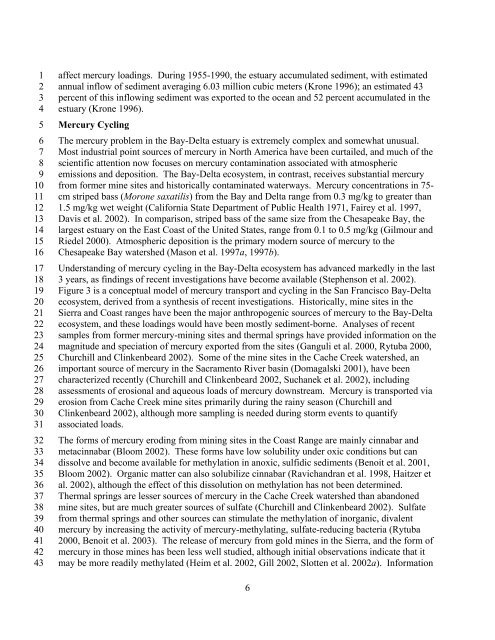Mercury Strategy for the Bay-Delta Ecosystem - CALFED Bay-Delta ...
Mercury Strategy for the Bay-Delta Ecosystem - CALFED Bay-Delta ...
Mercury Strategy for the Bay-Delta Ecosystem - CALFED Bay-Delta ...
You also want an ePaper? Increase the reach of your titles
YUMPU automatically turns print PDFs into web optimized ePapers that Google loves.
1<br />
2<br />
3<br />
4<br />
5<br />
6<br />
7<br />
8<br />
9<br />
10<br />
11<br />
12<br />
13<br />
14<br />
15<br />
16<br />
17<br />
18<br />
19<br />
20<br />
21<br />
22<br />
23<br />
24<br />
25<br />
26<br />
27<br />
28<br />
29<br />
30<br />
31<br />
32<br />
33<br />
34<br />
35<br />
36<br />
37<br />
38<br />
39<br />
40<br />
41<br />
42<br />
43<br />
affect mercury loadings. During 1955-1990, <strong>the</strong> estuary accumulated sediment, with estimated<br />
annual inflow of sediment averaging 6.03 million cubic meters (Krone 1996); an estimated 43<br />
percent of this inflowing sediment was exported to <strong>the</strong> ocean and 52 percent accumulated in <strong>the</strong><br />
estuary (Krone 1996).<br />
<strong>Mercury</strong> Cycling<br />
The mercury problem in <strong>the</strong> <strong>Bay</strong>-<strong>Delta</strong> estuary is extremely complex and somewhat unusual.<br />
Most industrial point sources of mercury in North America have been curtailed, and much of <strong>the</strong><br />
scientific attention now focuses on mercury contamination associated with atmospheric<br />
emissions and deposition. The <strong>Bay</strong>-<strong>Delta</strong> ecosystem, in contrast, receives substantial mercury<br />
from <strong>for</strong>mer mine sites and historically contaminated waterways. <strong>Mercury</strong> concentrations in 75cm<br />
striped bass (Morone saxatilis) from <strong>the</strong> <strong>Bay</strong> and <strong>Delta</strong> range from 0.3 mg/kg to greater than<br />
1.5 mg/kg wet weight (Cali<strong>for</strong>nia State Department of Public Health 1971, Fairey et al. 1997,<br />
Davis et al. 2002). In comparison, striped bass of <strong>the</strong> same size from <strong>the</strong> Chesapeake <strong>Bay</strong>, <strong>the</strong><br />
largest estuary on <strong>the</strong> East Coast of <strong>the</strong> United States, range from 0.1 to 0.5 mg/kg (Gilmour and<br />
Riedel 2000). Atmospheric deposition is <strong>the</strong> primary modern source of mercury to <strong>the</strong><br />
Chesapeake <strong>Bay</strong> watershed (Mason et al. 1997a, 1997b).<br />
Understanding of mercury cycling in <strong>the</strong> <strong>Bay</strong>-<strong>Delta</strong> ecosystem has advanced markedly in <strong>the</strong> last<br />
3 years, as findings of recent investigations have become available (Stephenson et al. 2002).<br />
Figure 3 is a conceptual model of mercury transport and cycling in <strong>the</strong> San Francisco <strong>Bay</strong>-<strong>Delta</strong><br />
ecosystem, derived from a syn<strong>the</strong>sis of recent investigations. Historically, mine sites in <strong>the</strong><br />
Sierra and Coast ranges have been <strong>the</strong> major anthropogenic sources of mercury to <strong>the</strong> <strong>Bay</strong>-<strong>Delta</strong><br />
ecosystem, and <strong>the</strong>se loadings would have been mostly sediment-borne. Analyses of recent<br />
samples from <strong>for</strong>mer mercury-mining sites and <strong>the</strong>rmal springs have provided in<strong>for</strong>mation on <strong>the</strong><br />
magnitude and speciation of mercury exported from <strong>the</strong> sites (Ganguli et al. 2000, Rytuba 2000,<br />
Churchill and Clinkenbeard 2002). Some of <strong>the</strong> mine sites in <strong>the</strong> Cache Creek watershed, an<br />
important source of mercury in <strong>the</strong> Sacramento River basin (Domagalski 2001), have been<br />
characterized recently (Churchill and Clinkenbeard 2002, Suchanek et al. 2002), including<br />
assessments of erosional and aqueous loads of mercury downstream. <strong>Mercury</strong> is transported via<br />
erosion from Cache Creek mine sites primarily during <strong>the</strong> rainy season (Churchill and<br />
Clinkenbeard 2002), although more sampling is needed during storm events to quantify<br />
associated loads.<br />
The <strong>for</strong>ms of mercury eroding from mining sites in <strong>the</strong> Coast Range are mainly cinnabar and<br />
metacinnabar (Bloom 2002). These <strong>for</strong>ms have low solubility under oxic conditions but can<br />
dissolve and become available <strong>for</strong> methylation in anoxic, sulfidic sediments (Benoit et al. 2001,<br />
Bloom 2002). Organic matter can also solubilize cinnabar (Ravichandran et al. 1998, Haitzer et<br />
al. 2002), although <strong>the</strong> effect of this dissolution on methylation has not been determined.<br />
Thermal springs are lesser sources of mercury in <strong>the</strong> Cache Creek watershed than abandoned<br />
mine sites, but are much greater sources of sulfate (Churchill and Clinkenbeard 2002). Sulfate<br />
from <strong>the</strong>rmal springs and o<strong>the</strong>r sources can stimulate <strong>the</strong> methylation of inorganic, divalent<br />
mercury by increasing <strong>the</strong> activity of mercury-methylating, sulfate-reducing bacteria (Rytuba<br />
2000, Benoit et al. 2003). The release of mercury from gold mines in <strong>the</strong> Sierra, and <strong>the</strong> <strong>for</strong>m of<br />
mercury in those mines has been less well studied, although initial observations indicate that it<br />
may be more readily methylated (Heim et al. 2002, Gill 2002, Slotten et al. 2002a). In<strong>for</strong>mation<br />
6

















